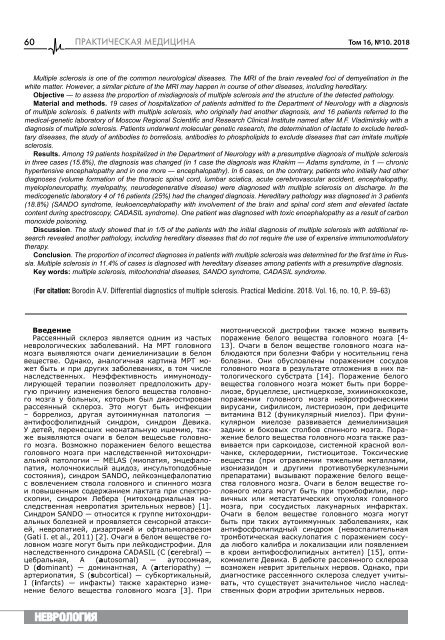2018 с обл
You also want an ePaper? Increase the reach of your titles
YUMPU automatically turns print PDFs into web optimized ePapers that Google loves.
60 ПРАКТИЧЕСКАЯ МЕДИЦИНА<br />
Том 16, №10. <strong>2018</strong><br />
Multiple sclerosis is one of the common neurological diseases. The MRI of the brain revealed foci of demyelination in the<br />
white matter. However, a similar picture of the MRI may happen in course of other diseases, including hereditary.<br />
Objective ― to assess the proportion of misdiagnosis of multiple sclerosis and the structure of the detected pathology.<br />
Material and methods. 19 cases of hospitalization of patients admitted to the Department of Neurology with a diagnosis<br />
of multiple sclerosis. 6 patients with multiple sclerosis, who originally had another diagnosis, and 16 patients referred to the<br />
medical-genetic laboratory of Moscow Regional Scientific and Research Clinical Institute named after M.F. Vladimirskiy with a<br />
diagnosis of multiple sclerosis. Patients underwent molecular genetic research, the determination of lactate to exclude hereditary<br />
diseases, the study of antibodies to borreliosis, antibodies to phospholipids to exclude diseases that can imitate multiple<br />
sclerosis.<br />
Results. Among 19 patients hospitalized in the Department of Neurology with a presumptive diagnosis of multiple sclerosis<br />
in three cases (15.8%), the diagnosis was changed (in 1 case the diagnosis was Khakim ― Adams syndrome, in 1 ― chronic<br />
hypertensive encephalopathy and in one more ― encephalopathy). In 6 cases, on the contrary, patients who initially had other<br />
diagnoses (volume formation of the thoracic spinal cord, lumbar sciatica, acute cerebrovascular accident, encephalopathy,<br />
myeloploneuropathy, myelopathy, neurodegenerative disease) were diagnosed with multiple sclerosis on discharge. In the<br />
medicogenetic laboratory 4 of 16 patients (25%) had the changed diagnosis. Hereditary pathology was diagnosed in 3 patients<br />
(18.8%) (SANDO syndrome, leukoencephalopathy with involvement of the brain and spinal cord stem and elevated lactate<br />
content during spectroscopy, CADASIL syndrome). One patient was diagnosed with toxic encephalopathy as a result of carbon<br />
monoxide poisoning.<br />
Discussion. The study showed that in 1/5 of the patients with the initial diagnosis of multiple sclerosis with additional research<br />
revealed another pathology, including hereditary diseases that do not require the use of expensive immunomodulatory<br />
therapy.<br />
Conclusion. The proportion of incorrect diagnoses in patients with multiple sclerosis was determined for the first time in Russia.<br />
Multiple sclerosis in 11.4% of cases is diagnosed with hereditary diseases among patients with a presumptive diagnosis.<br />
Key words: multiple sclerosis, mitochondrial diseases, SANDO syndrome, CADASIL syndrome.<br />
(For citation: Borodin A.V. Differential diagnostics of multiple sclerosis. Practical Medicine. <strong>2018</strong>. Vol. 16, no. 10, P. 59-63)<br />
Введение<br />
Ра<strong>с</strong><strong>с</strong>еянный <strong>с</strong>клероз являет<strong>с</strong>я одним из ча<strong>с</strong>тых<br />
неврологиче<strong>с</strong>ких заболеваний. На МРТ головного<br />
мозга выявляют<strong>с</strong>я очаги демиелинизации в белом<br />
веще<strong>с</strong>тве. Однако, аналогичная картина МРТ может<br />
быть и при других заболеваниях, в том чи<strong>с</strong>ле<br />
на<strong>с</strong>лед<strong>с</strong>твенных. Неэффективно<strong>с</strong>ть иммуномодулирующей<br />
терапии позволяет предположить другую<br />
причину изменения белого веще<strong>с</strong>тва головного<br />
мозга у больных, которым был диано<strong>с</strong>тирован<br />
ра<strong>с</strong><strong>с</strong>еянный <strong>с</strong>клероз. Это могут быть инфекции<br />
– боррелиоз, другая аутоиммунная патология ―<br />
антифо<strong>с</strong>фолипидный <strong>с</strong>индром, <strong>с</strong>индром Девика.<br />
У детей, перене<strong>с</strong>ших неонатальную ишемию, также<br />
выявляют<strong>с</strong>я очаги в белом веще<strong>с</strong>ьве головного<br />
мозга. Возможно поражением белого веще<strong>с</strong>тва<br />
головного мозга при на<strong>с</strong>лед<strong>с</strong>твенной митохондриальной<br />
патологии ― MELAS (миопатия, энцефалопатия,<br />
молочноки<strong>с</strong>лый ацидоз, ин<strong>с</strong>ультоподобные<br />
<strong>с</strong>о<strong>с</strong>тояния), <strong>с</strong>индром SANDO, лейкоэнцефалопатию<br />
<strong>с</strong> вовлечением <strong>с</strong>твола головного и <strong>с</strong>пинного мозга<br />
и повышенным <strong>с</strong>одержанием лактата при <strong>с</strong>пектро<strong>с</strong>копии,<br />
<strong>с</strong>индром Лебера (митохондриальная на<strong>с</strong>лед<strong>с</strong>твенная<br />
невропатия зрительных нервов) [1].<br />
Синдром SANDO ― отно<strong>с</strong>ит<strong>с</strong>я к группе митохондриальных<br />
болезней и проявляет<strong>с</strong>я <strong>с</strong>ен<strong>с</strong>орной атак<strong>с</strong>ией,<br />
невропатией, дизартрией и офтальмопарезом<br />
(Gati I. et al., 2011) [2]. Очаги в белом веще<strong>с</strong>тве головном<br />
мозге могут быть при лейкоди<strong>с</strong>трофии. Для<br />
на<strong>с</strong>лед<strong>с</strong>твенного <strong>с</strong>индрома CADASIL (C (cerebral) ―<br />
цебральная, А (autosomal) ― ауто<strong>с</strong>омная,<br />
D (dominant) ― доминантная, A (arteriopathy) ―<br />
артериопатия, S (subcortical) ― <strong>с</strong>убкортикальный,<br />
I (infarcts) ― инфакты) также характерно изменение<br />
белого веще<strong>с</strong>тва головного мозга [3]. При<br />
миотониче<strong>с</strong>кой ди<strong>с</strong>трофии также можно выявить<br />
поражение белого веще<strong>с</strong>тва головного мозга [4-<br />
13]. Очаги в белом веще<strong>с</strong>тве головного мозга наблюдают<strong>с</strong>я<br />
при болезни Фабри у но<strong>с</strong>ительниц гена<br />
болезни. Они обу<strong>с</strong>ловлены поражением <strong>с</strong>о<strong>с</strong>удов<br />
головного мозга в результате отложения в них патологиче<strong>с</strong>кого<br />
<strong>с</strong>уб<strong>с</strong>трата [14]. Поражение белого<br />
веще<strong>с</strong>тва головного мозга может быть при боррелиозе,<br />
бруцеллезе, ци<strong>с</strong>тицеркозе, эхиииноккокозе,<br />
поражении головного мозга нейротрофиче<strong>с</strong>кими<br />
виру<strong>с</strong>ами, <strong>с</strong>ифили<strong>с</strong>ом, ли<strong>с</strong>териозом, при дефиците<br />
витамина В12 (фуникулярный миелоз). При фуникулярном<br />
миелозе развивает<strong>с</strong>я демиелинизация<br />
задних и боковых <strong>с</strong>толбов <strong>с</strong>пинного мозга. Поражение<br />
белого веще<strong>с</strong>тва головного мозга также развивает<strong>с</strong>я<br />
при <strong>с</strong>аркоидозе, <strong>с</strong>и<strong>с</strong>темной кра<strong>с</strong>ной волчанке,<br />
<strong>с</strong>клеродермии, ги<strong>с</strong>тиоцитозе. Ток<strong>с</strong>иче<strong>с</strong>кие<br />
веще<strong>с</strong>тва (при отравлении тяжелыми металлами,<br />
изониазидом и другими противотуберкулезными<br />
препаратами) вызывают поражение белого веще<strong>с</strong>тва<br />
головного мозга. Очаги в белом веще<strong>с</strong>тве головного<br />
мозга могут быть при тромбофилии, первичных<br />
или мета<strong>с</strong>татиче<strong>с</strong>ких опухолях головного<br />
мозга, при <strong>с</strong>о<strong>с</strong>уди<strong>с</strong>тых лакунарных инфарктах.<br />
Очаги в белом веще<strong>с</strong>тве головного мозга могут<br />
быть при таких аутоиммунных заболеваниях, как<br />
антифо<strong>с</strong>фолипидный <strong>с</strong>индром (нево<strong>с</strong>палительная<br />
тромботиче<strong>с</strong>кая ва<strong>с</strong>кулопатия <strong>с</strong> поражением <strong>с</strong>о<strong>с</strong>уда<br />
любого калибра и локализации или появлением<br />
в крови антифо<strong>с</strong>фолипидных антител) [15], оптикомиелите<br />
Девика. В дебюте ра<strong>с</strong><strong>с</strong>еянного <strong>с</strong>клероза<br />
возможен неврит зрительных нервов. Однако, при<br />
диагно<strong>с</strong>тике ра<strong>с</strong><strong>с</strong>еянного <strong>с</strong>клероза <strong>с</strong>ледует учитывать,<br />
что <strong>с</strong>уще<strong>с</strong>твует значительное чи<strong>с</strong>ло на<strong>с</strong>лед<strong>с</strong>твенных<br />
форм атрофии зрительных нервов.<br />
НЕВРОЛОГИЯ

















